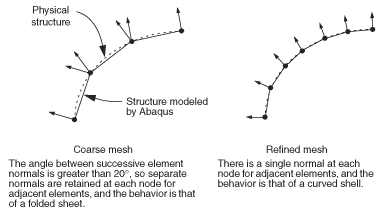Initial shell curvature | ||
| ||
With a coarse mesh as shown in Figure 1, Abaqus may determine several independent surface normals at the same node for adjoining elements. Physically, multiple normals at a single node mean that there is a fold line between the elements sharing the node. While it is possible that you intend to model such a structure, it is more likely that you intend to model a smoothly curved shell; Abaqus will try to smooth the shell by creating an averaged normal at a node.

The basic smoothing algorithm used is as follows: if the normals at a node for each shell element attached to the node are within 20° of each other, the normals will be averaged. The averaged normal will be used at that node for all elements attached to the node. If Abaqus cannot smooth the shell, a warning message is issued in the data (.dat) file.
There are two methods that can be used to override the default algorithm. To introduce fold lines into a curved shell, either give the components of as the 4th, 5th, and 6th data values following the nodal coordinates (this method requires manually editing the input file created by Abaqus/CAE in a text editor); or specify the normal direction directly with the NORMAL option (this option can be added using the Abaqus/CAE Keywords Editor; see Cross-section orientation). If both methods are used, the latter takes precedence. See Defining the initial geometry of conventional shell elements for further details.